QNAP TS-451 Bay Trail NAS Performance Review
by Ganesh T S on July 28, 2014 9:00 AM ESTSingle Client Performance - CIFS on Windows
The single client CIFS and iSCSI performance of the QNAP TS-451 was evaluated on the Windows platforms using Intel NASPT and our standard robocopy benchmark. This was run from one of the virtual machines in our NAS testbed. All data for the robocopy benchmark on the client side was put in a RAM disk (created using OSFMount) to ensure that the client's storage system shortcomings wouldn't affect the benchmark results. It must be noted that all the shares / iSCSI LUNs are created in a RAID-5 volume. The TS-451 manages to compare favourably against every other 4-bay NAS unit that we have evaluated with our new methodology. Benchmark numbers are provided in the graphs below.
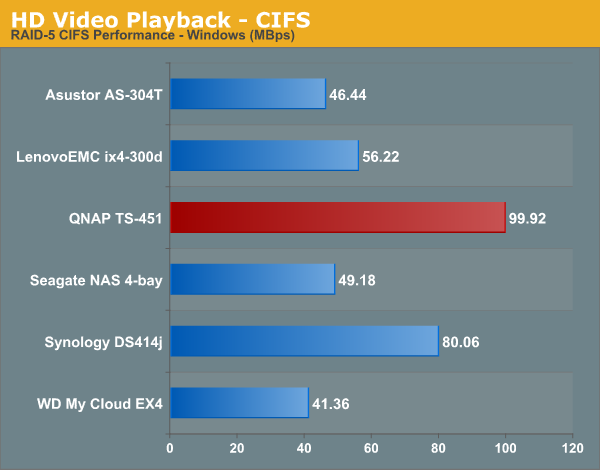
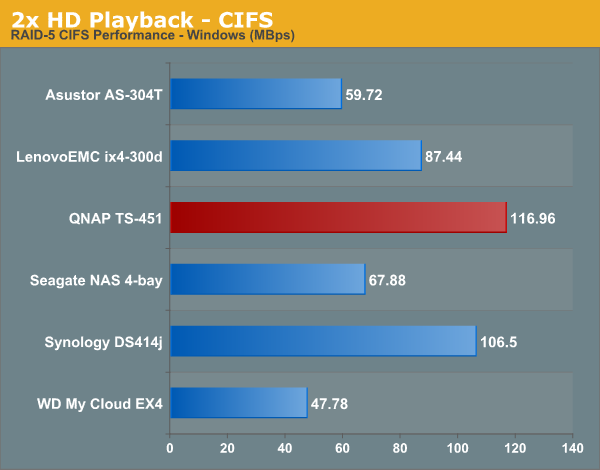
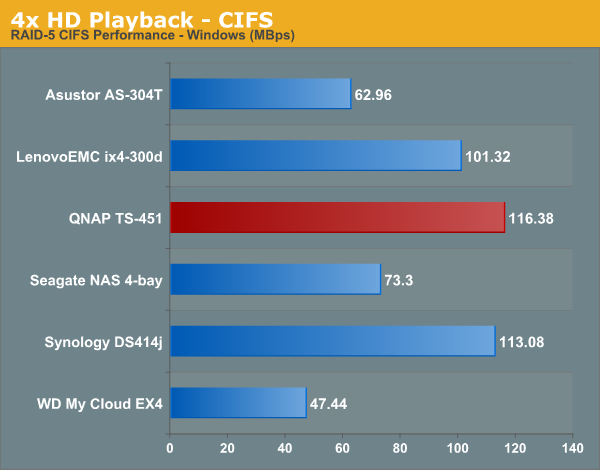

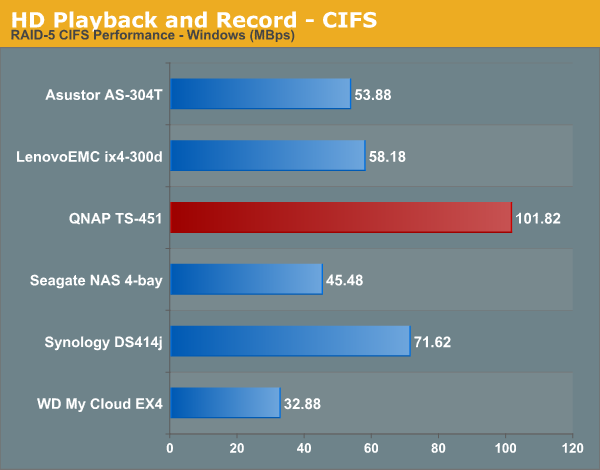
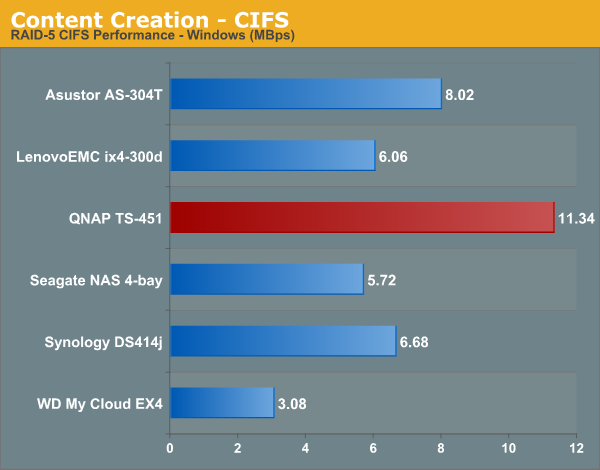
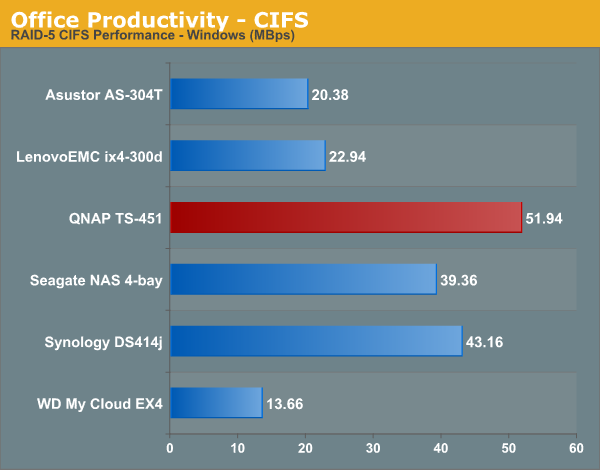
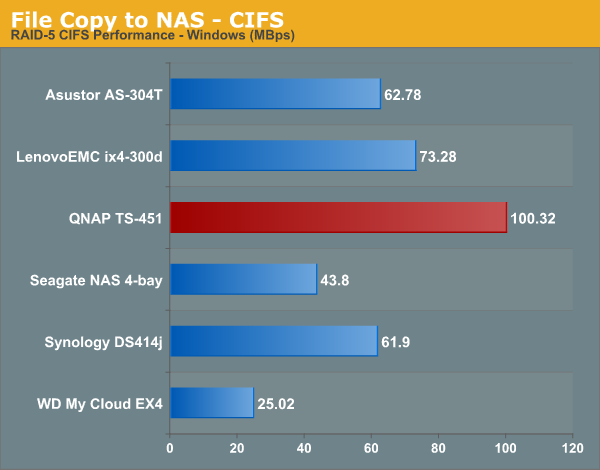
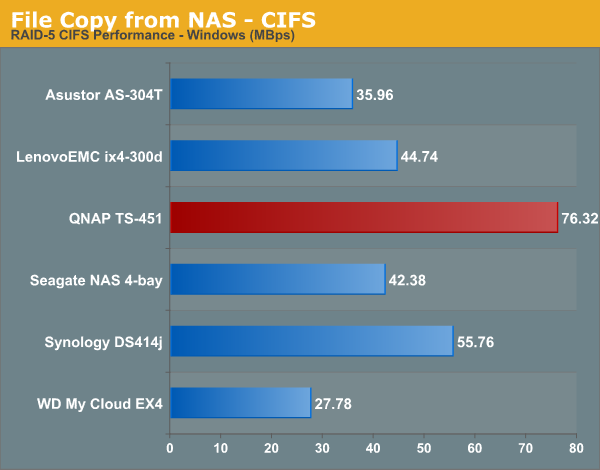
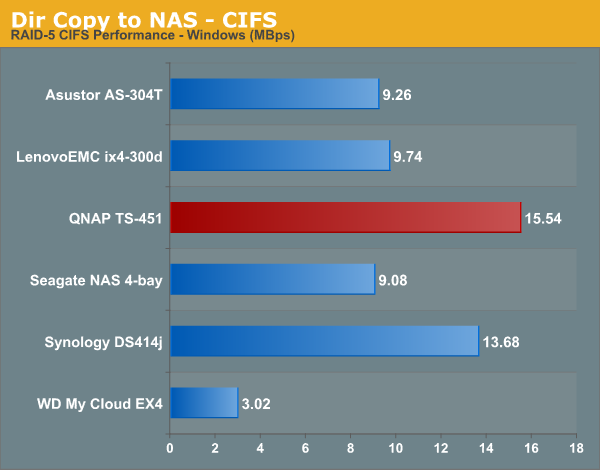

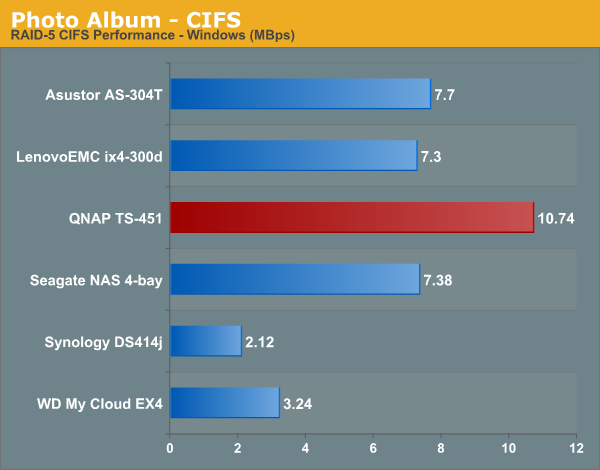

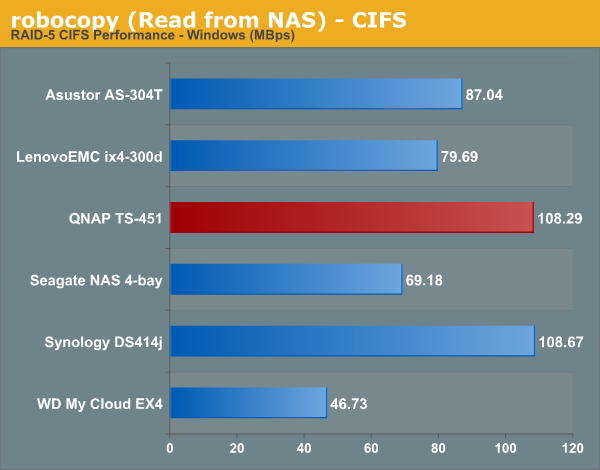










55 Comments
View All Comments
DanNeely - Monday, July 28, 2014 - link
I currently retire my old computers by making an image of their HD and parking it on my NAS so I can recover files and (theoretically) bring the whole system up as a VM or on spare hardware if I needed access to some software on it. As a result, I'd be interested in seeing how well it can run an image of a well used working computer in addition to the standard stripped down OS with a single application setup that a conventional VM hosts. I know Baytrail is much slower than the i7 of my main system; but knowing that all the cruft that accumulates after using a system for a half dozen years won't strangle the NAS would be reassuring.eliluong - Monday, July 28, 2014 - link
What software do you use to image your old drives? And what VM software do you boot it up in? Is the image usable, given that in the VM all the hardware will be different?Samus - Monday, July 28, 2014 - link
I just sysprep and capture the image with WDS which can redeploy using WinPE via PXE (network) or USB. I still use a Windows 2008 server for this, but 2012 with Hyper-V gives the flexibility of snapshots before/after sysprepping which helps prevent running into that sealing limitation (3 syspreps before it craps out) of images. I typically refresh my corporate image quarterly with Windows Updates, Office Updates, Adobe Updates, Driver Updates, and profile tweaks.Hyper-V definitely has the edge on VMware for imaging because of how easy it is to convert a VXD to a universal image. You can go straight from Hyper-V to WDS, and vice versa (I can turn any PC on the network into a VXD through WDS capture, and virtualize, say, a legacy PC running legacy software that's currently on a KVM and annoying someone as they have to switch between it and their main PC. This is still preferable over XP Mode in Windows 7 because of XP Modes lack of snapshots, poor remote management and inability to backup while the machine is running.
eliluong - Monday, July 28, 2014 - link
Thanks for the informative reply. I'm not in the IT field so this new to me. I've dabbled with virtual machines, but not in this manner. For a home-use case, where I have a 500GB system running XP that I want to have accessible in a virtualized environment, is this something what you described is capable of, or is it intended to just run one or two applications?Samus - Monday, July 28, 2014 - link
You could use VMware, XP Mode or Hyper-V (Windows 2012 Server) to completely emulate a PC. VMWare and Hyper-V both offer tools to take an image of a physical machine and turn it into a virtual machine. They do this by stripping the HAL (hardware layer) and generalizing the image, so the next time it boots up, whether it be on different physical hardware are emulated virtual hardware, it rebuilds the HAL. In Windows 7, you'll see "detecting hardware" on the first boot, in Windows XP, it actually just goes through the second-phase of the XP setup again.Vista and Windows 7 brought Windows PE (preexecution environment) into the picture which makes low-level Windows deployment easier. For example, if your XP machine is running IDE mode (not AHCI) it's pretty tricky to get it to run in a Hyper-V machine, but there is a lengthy process for doing so. Windows Vista and newer can dynamically boot between SATA controllers, command configurations, etc. Windows 8 is even better, having the most feature-rich WinPE environment, with native bare-metal recovery (easily restore any system image to any hardware configuration without generalizing) but Windows 8 is hated on in corporate sectors, so us IT engineers are stuck dealing with Winodws 7's inferior manageability.
rufuselder - Thursday, October 9, 2014 - link
I like it, although I think there are some better storage options out there... /Rufus from http://www.consumertop.com/best-computer-storage-g...blaktron - Tuesday, July 29, 2014 - link
Hey, if you do this often enough, what you should do is just run your system off a vhdx right from the get go. Its actually pretty good for a couple of reasons if you don't mind losing a % or 2 of random performance and total space.Here is a link that explains what I am talking about, but Windows 7 and 8 support this, and it works pretty well:
http://technet.microsoft.com/en-us/library/hh82569...
Oyster - Monday, July 28, 2014 - link
Since you asked for feedback, Ganesh:1) It goes without saying that all your reviews focus too heavily on the hardware. You need to dedicate more time to the software/OS and the app ecosystem for these offerings. I personally have a QNAP TS 470, and can't see myself switching to a competitor unless their offerings consist of basic functionality like "ipkg", myQNAPcloud, Qsync, etc. There's no way for me to reach a decision unless you cover these areas :).
2) For VM performance, I realize that most of the NAS vendors are going to want you to benchmark under ideal conditions (e.g. iSCSI only). But it would be awesome if you can cover non-iSCSI performance.
3) Please, please add an additional test to cover the effectiveness of these devices to recover from failures. This would allow us to figure out how effective the RAID software implementation is.
Thanks.
Kevin G - Monday, July 28, 2014 - link
I'll second the request for some more attention to software and failure recovery.ganeshts - Monday, July 28, 2014 - link
I already do testing for RAID rebuild after simulating a drive failure by just yanking out one of the disks at random. Rebuild times as well as power consumption numbers for that operation are reported in the review. In case of any issues, I do make a note of what was encountered (for example, in this review, I noted that reinserting a disk with pre-existing partitions might sometime cause the 'hot-swap' rebuild to not take effect.What other 'failure recovery' testing do you want to see?